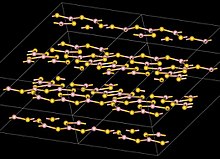
| |
| Names | |
|---|---|
| IUPAC name
Boron sulfide
| |
| Other names
Boron sesquisulfide, Diboron trisulfide
| |
| Identifiers | |
3D model (JSmol)
|
|
| ECHA InfoCard | 100.031.355 |
| EC Number |
|
PubChem CID
|
|
CompTox Dashboard (EPA)
|
|
| |
| |
| Properties | |
| B2S3 | |
| Molar mass | 117.80 g/mol |
| Appearance | colorless crystals |
| Density | 1.55 g/cm3, solid |
| Melting point | 563 °C (1,045 °F; 836 K) |
| Boiling point | decomposes at high T |
| decomposes | |
| Solubility | soluble in ammonia |
| Structure | |
| monoclinic, mP40, SpaceGroup = P21/c, No. 14 | |
| B: planar, sp2 | |
| Thermochemistry | |
Heat capacity (C)
|
111.7 J/mol K |
Std molar
entropy (S⦵298) |
327 J/mol K |
Std enthalpy of
formation (ΔfH⦵298) |
-240.6 kJ/mol |
| Hazards | |
| Occupational safety and health (OHS/OSH): | |
Main hazards
|
source of H2S |
| GHS labelling: | |
  
| |
| Danger | |
| H225, H260, H301, H311, H315, H318, H335 | |
| P210, P223, P231+P232, P280, P302+P352, P303+P361+P353, P305+P351+P338, P312, P402+P404, P405 | |
| NFPA 704 (fire diamond) | |
| Flash point | 18°C (64.4°F) |
| Safety data sheet (SDS) | trc-canada.com |
| Related compounds | |
Related compounds
|
BCl3 Lawesson's reagent |
Except where otherwise noted, data are given for materials in their standard state (at 25 °C [77 °F], 100 kPa).
| |
Boron sulfide is the chemical compound with the formula B2S3. It is a white, moisture-sensitive solid. It has a polymeric structure. The material has been of interest as a component of "high-tech" glasses and as a reagent for preparing organosulfur compounds.
Reactions[edit]
Like the sulfides of silicon and phosphorus, B2S3 reacts with traces of water, including atmospheric moisture to release H2S. This hydrolysis is described by the following idealized equation:
- B2S3 + 3 H2O → B2O3 + 3 H2S
B2S3 readily forms glasses when blended with other sulfides such as P4S10. Such glasses do not absorb mid-frequencies of Infra-red energy relative to conventional borosilicate glasses. Some of these ternary phases that are fast ion conductors.[2]
B2S3 converts ketones into the corresponding thiones. For example, the conversion of benzophenone to its thione proceeds as follows:
- B2S3 + 3 (C6H5)2C=O → B2O3 + 3 (C6H5)2C=S
In practice, B2S3 would be used in excess.[3]
Synthesis[edit]
An early synthesis involved the reaction of iron and manganese borides with hydrogen sulfide at temperatures of 300 °C. The conversion is shown for the monoborides in the following idealized equation:[4]
- 2 FeB + 4 H2S → B2S3 + FeS + 4 H2
The first synthesis was done by Jöns Jakob Berzelius in 1824 by direct reaction of amorphous boron with sulfur vapor.[5]
- 2 B + 3 S → B2S3
Another synthesis was favoured by Friedrich Wöhler and Henri Etienne Sainte-Claire Deville first published in 1858, starting from boron and hydrogen sulfide.[6][7]
- 2 B + 3 H2S → B2S3 + 3 H2
Structure[edit]
The boron atoms in B2S3 are trigonal planar, and are arranged in B3S3 and B2S2 rings with bridging S atoms forming a layer structure with an interlayer distance of 355 pm. This is different from boron trioxide which has a three dimensional structure.[8] The molecular, monomeric, form of B2S3 has a planar V shape with the central B-S-B angle of approximately 120°.[8]
References[edit]
- ^ Material Safety Data Sheet, VWR, 2010, retrieved November 11, 2023
- ^ Kincs, Joseph; Martin, Steve W. (1996). "Non-Arrhenius Conductivity in Glass: Mobility and Conductivity Saturation Effects". Physical Review Letters. 76 (1): 70–73. Bibcode:1996PhRvL..76...70K. doi:10.1103/physrevlett.76.70. PMID 10060436.
- ^ Sato, R. (2004). "Boron Trisulfide". In L. Paquette (ed.). Encyclopedia of Reagents for Organic Synthesis. New York: J. Wiley & Sons. doi:10.1002/047084289X.rb255. ISBN 0471936235.
- ^ Hoffmann, J. (1908). "Synthese von Borsulfid aus Ferro- und Manganbor". Zeitschrift für anorganische Chemie. 59 (1): 127–135. doi:10.1002/zaac.19080590116.
- ^ Berzelius, J. (1824). "Undersökning af flusspatssyran och dess märkvärdigaste föreningar" [Investigation of hydrofluoric acid and of its most noteworthy compounds]. Kongliga Vetenskaps-Academiens Handlingar [Proceedings of the Royal Science Academy]. 12: 46–98.
Reprinted in German as:
Berzelius, J. J. (1824). "Untersuchungen über die Flußspathsäure und deren merkwürdigsten Verbindungen". Annalen der Physik und Chemie. 78 (10): 113–150. Bibcode:1824AnP....78..113B. doi:10.1002/andp.18240781002. see especially pages 145–147. - ^ Wöhler, F.; Deville, H. E. S.-C. (1858). "Neue Beobachtungen über das Bor und einige seiner Verbindungen" [New observations concerning boron and some of its compounds]. Liebigs Annalen der Chemie und Pharmacie. 105 (1): 67–73. doi:10.1002/jlac.18581050109.
- ^ Wöhler, F.; Deville, H. E. S.-C. (1858). "Du Bore". Annales de Chimie et de Physique. 52: 62–93.
- ^ a b Greenwood, Norman N.; Earnshaw, Alan (1997). Chemistry of the Elements (2nd ed.). Butterworth-Heinemann. ISBN 978-0-08-037941-8.
